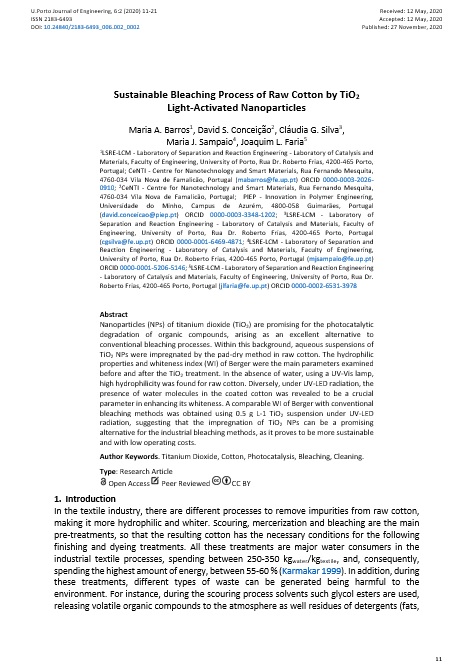Sustainable Bleaching Process of Raw Cotton by TiO2 Light-Activated Nanoparticles
Main Article Content
Abstract
Nanoparticles (NPs) of titanium dioxide (TiO2) are promising for the photocatalytic degradation of organic compounds, arising as an excellent alternative to conventional bleaching processes. Within this background, aqueous suspensions of TiO2 NPs were impregnated by the pad-dry method in raw cotton. The hydrophilic properties and whiteness index (WI) of Berger were the main parameters examined before and after the TiO2 treatment. In the absence of water, using a UV-Vis lamp, high hydrophilicity was found for raw cotton. Diversely, under UV-LED radiation, the presence of water molecules in the coated cotton was revealed to be a crucial parameter in enhancing its whiteness. A comparable WI of Berger with conventional bleaching methods was obtained using 0.5 g L-1 TiO2 suspension under UV-LED radiation, suggesting that the impregnation of TiO2 NPs can be a promising alternative for the industrial bleaching methods, as it proves to be more sustainable and with low operating costs.
Downloads
Article Details
Authors who publish with this journal agree to the following terms:
- Authors retain copyright and grant the journal right of first publication with the work simultaneously licensed under a Creative Commons Attribution License that allows others to share the work with an acknowledgement of the work's authorship and initial publication in this journal.
- Authors grant the journal the rights to provide the article in all forms and media so the article can be used on the latest technology even after publication and ensure its long-term preservation.
- Authors are able to enter into separate, additional contractual arrangements for the non-exclusive distribution of the journal's published version of the work (e.g., post it to an institutional repository or publish it in a book), with an acknowledgement of its initial publication in this journal.
- Authors are permitted and encouraged to post their work online (e.g., in institutional repositories or on their website) prior to and during the submission process, as it can lead to productive exchanges, as well as earlier and greater citation of published work (See The Effect of Open Access).

